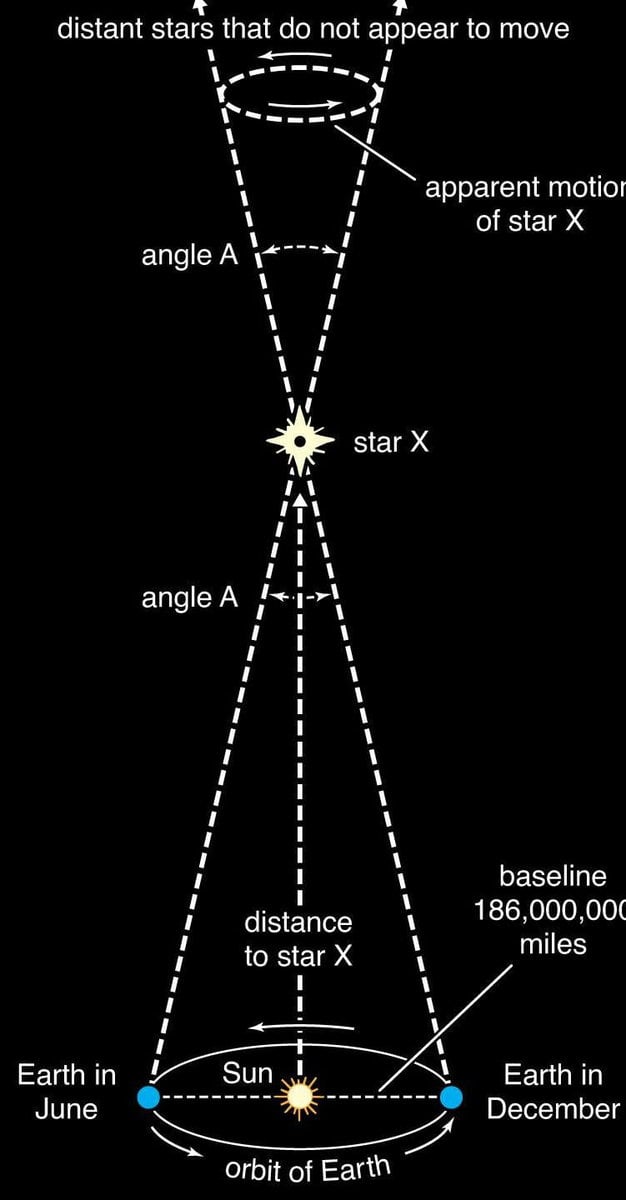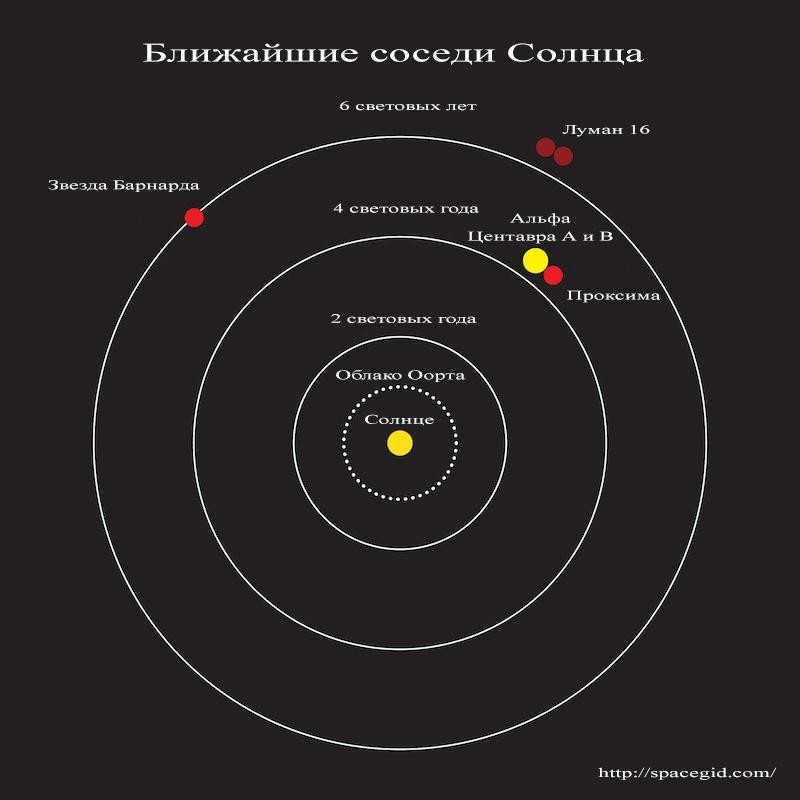
The Sun, the fundamental element of our solar system, is the nearest star to Earth, which, unlike any other objects, we can clearly observe during the daytime. However, during the night, the rest of the luminous bodies in the vast cosmos become visible for observation. The exact number of stars that fill the Universe is incalculable. Nevertheless, scientists have identified and compiled a list of the nearest celestial bodies located within a 16 light-year radius. This list includes 57 star systems. Some of these systems consist of multiple stars, resulting in a total of 64 celestial bodies. Additionally, this list also includes 13 brown dwarfs, which are significantly less massive compared to other objects.
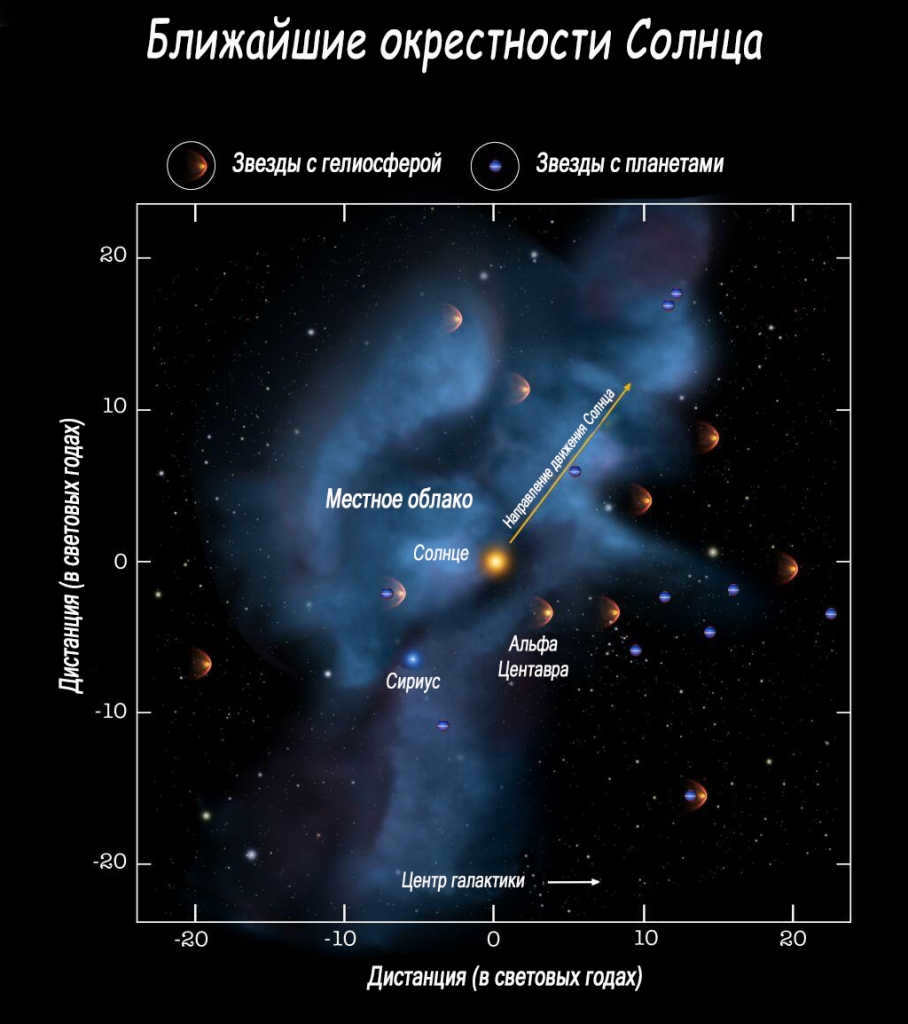
The Sun’s closest neighbors
There are only 7 stars on the list that we can observe without the need for optical amplification – Sirius, Alpha Centauri, Epsilon Eridanus, Procyon, Epsilon Indi, Tau Ceti, and 61 Cygni. All of these stars have apparent magnitudes ranging from 1.43 to 6.03. Most of them are red stars of spectral class M, with temperatures ranging from 2600-3800 K. The two hot stars on the list are Sirius A, a white star of spectral class A with a temperature of 9940 K, and Procyon A, a yellow-white star of spectral class F with a temperature of 6650 K. The list also includes brown dwarfs of spectral classes L, T, and Y. Additionally, there are 4 white dwarf stars of spectral class D, which are quite rare objects in the visible region of the Milky Way galaxy.
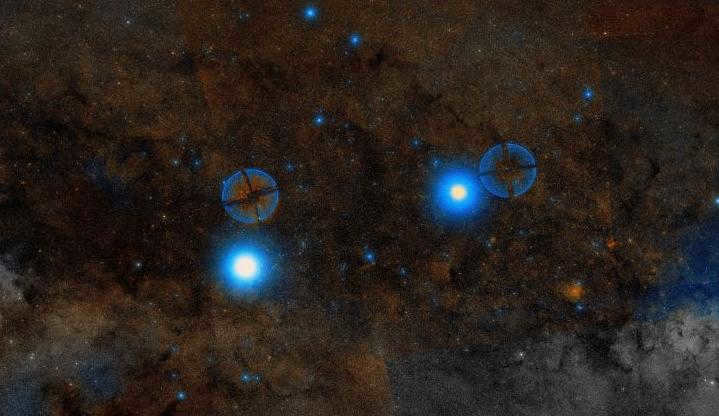
On the background of the Milky Way, there are two stars, Alpha Centauri (on the left) and Hadar (on the right).
Our planet is separated from Proxima Centauri, which is part of the Alpha Centauri star system, by a distance of 4.22 light-years. Unlike its neighboring stars, Proxima Centauri is the closest star to Earth (excluding the Sun) and has distinct characteristics. It belongs to the spectral class M (red dwarf) and has a mass and radius that are less than 0.1 times that of the Sun. With a low temperature of 3042 K, it emits minimal energy and cannot be seen with the naked eye. The star was first discovered in 1915. Periodic and active flares contribute to its overall brightness. Proxima Centauri and the rest of its star system are separated by a significant distance of 0.21 light-years, making it uncertain whether it is in orbit. If Proxima is confirmed to have a binary star system, its total orbital period would exceed 500,000 years. Despite extensive searches, no exoplanets have been found near this star, leading scientists to believe that large planets do not exist in its orbit.
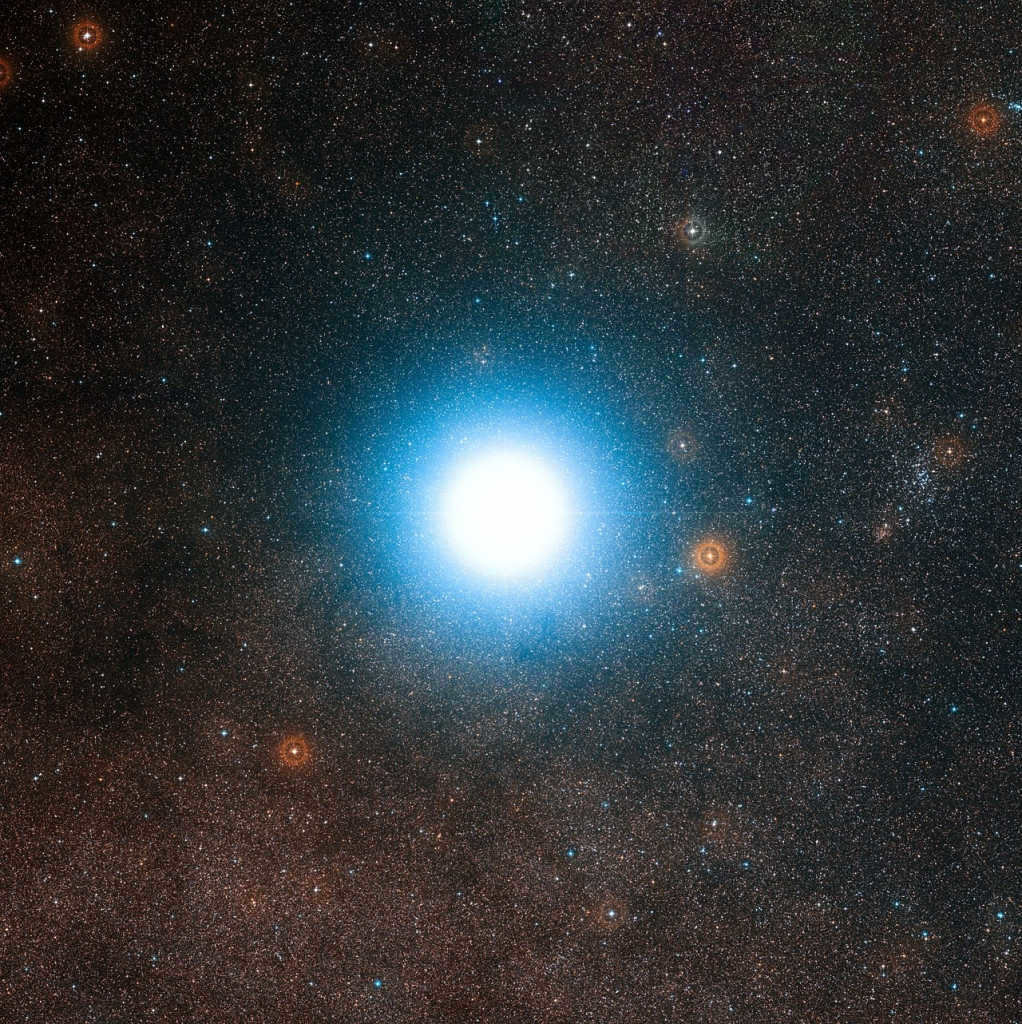
Alpha Centauri B
The two other components of the system – Alpha Centauri A and Alpha Centauri B – have a close interaction with each other. When viewed from Earth, they appear as a single star. The distance to the system is 4.36 light-years. These objects belong to the spectral classes G and K, which are yellow and orange dwarfs. They share similarities with the Sun in terms of characteristics and temperature, but they are older, with an age of 6 billion years. Alpha Centauri A is larger than its neighbor, with a mass of 1.1 and a diameter of 1.2 times that of the Sun. Alpha Centauri B, on the other hand, has values of 0.9 and 0.86 for mass and diameter, respectively. The stars rotate along an elliptical orbit, with an inclination angle of 79.2 degrees, and their orbital period is 79.9 years.
The Exoplanets in the Alpha Centauri System
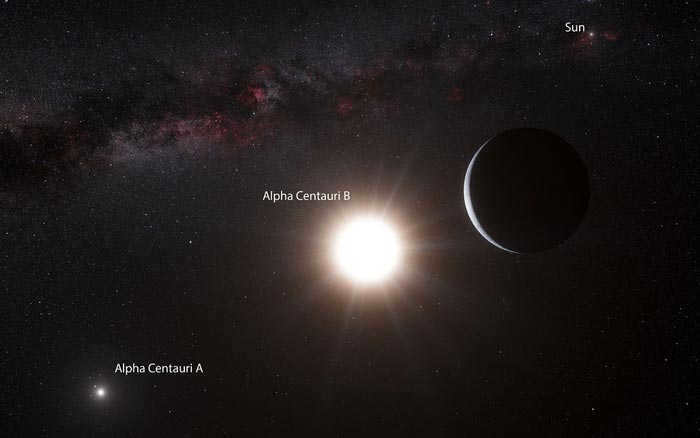

Alpha Centauri B’s Planets
Additional research and computational simulations provide optimism for the existence of a second, more massive and farther planet in the vicinity of Alpha Centauri B, with a rotational period of 20.4 days. Based on theoretical estimations, the occurrence of Centauri A’s influence would happen approximately every 70 years. With the inclusion of bodies of water, its barren terrain would be significantly more susceptible.
Barnard’s Star
Barnard’s Star is a fascinating celestial object that has captured the attention of astronomers for many years. This star, located in the constellation of Ophiuchus, is particularly interesting due to its proximity to Earth. In fact, it is the fourth closest known individual star to our solar system.
Named after the American astronomer Edward Emerson Barnard, who discovered it in 1916, Barnard’s Star has a relatively low mass and is classified as a red dwarf. It is estimated to be about six light-years away from Earth, making it one of our closest stellar neighbors.
Despite its proximity, Barnard’s Star is not visible to the naked eye. However, with the help of modern telescopes, scientists have been able to study this star in great detail. It has been found to have a high proper motion, meaning it moves relatively quickly across the sky. In fact, it has the largest proper motion of any known star.
Researchers have also detected evidence of a planetary system around Barnard’s Star. In 2018, they announced the discovery of a super-Earth planet orbiting the star. This planet, named Barnard’s Star b, is estimated to have a mass at least 3.2 times that of Earth and orbits its host star at a distance of about 0.4 astronomical units.
Studying Barnard’s Star and its planetary system can provide valuable insights into the formation and evolution of stars and planets. It also offers a unique opportunity to study nearby stellar systems that may have conditions suitable for the existence of life.
In conclusion, Barnard’s Star is a captivating celestial object that continues to intrigue astronomers. Its proximity to Earth, high proper motion, and the presence of a planetary system make it a fascinating subject of study. With further research and advancements in technology, we may uncover even more secrets about this intriguing star.


Barnard’s star in the infrared
The star, which was discovered by E. Barnard in 1916 and named after him, belongs to the M spectral class. It is a red dwarf located in the equatorial constellation of Serpens, approximately 5.96 light-years away from Earth. This small star is much smaller than our Sun, with a mass and diameter only 0.17 times that of the Sun. Despite not being visible to the naked eye, it is the fourth closest star to us. Known as the “Flying Barnard,” it is famous for its rapid motion, which is directed towards our Sun. In the future, it will even be closer to us than Proxima Centauri. It travels at a record-breaking speed of 10.36 angular seconds per year.
The existence of planets
For many years, a team of researchers in California has been diligently working to uncover the presence of planets around Barnard’s star. However, despite their persistent efforts, no concrete evidence has been found thus far.
Luman 16
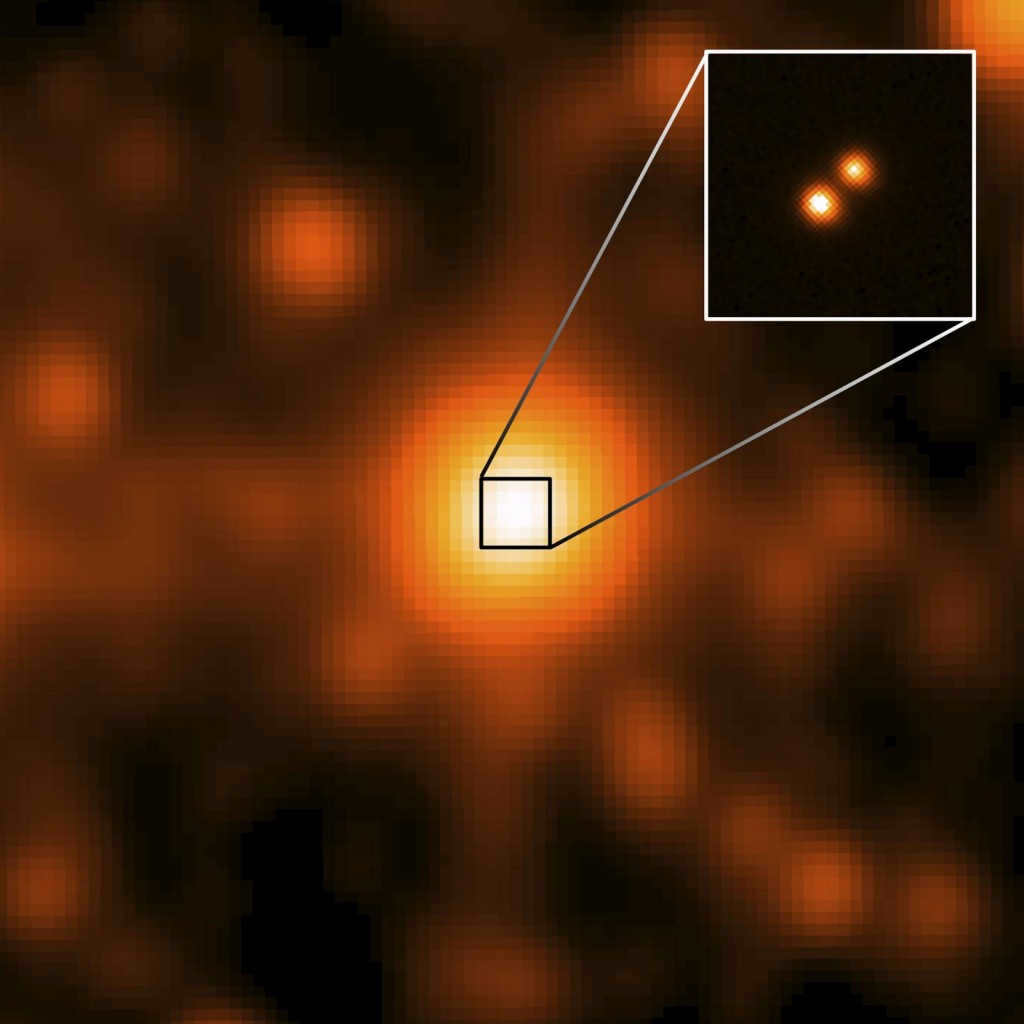
Luhmann 16 AB
The constellation Sails, situated in the Southern Hemisphere, has transformed into a sanctuary for a binary system of dwarf brown stars, which are the closest neighbors to our Sun. Luman 16 is located at a distance of 6.59 light-years. The two components of this system bear a striking resemblance to each other, with a mass ranging from 0.4 to 0.5 times that of our Sun. The rotation period of this binary system spans two decades. No other celestial bodies have been observed in the vicinity of this double star system.
It will take 70 thousand years for Earth’s spacecraft to reach Proxima Centauri, our nearest neighbor in space.
The double star Alpha Centauri has components that are 22 angular seconds apart. When viewed with the naked eye, they appear as one, but with even the simplest telescope, they can be seen as separate. The angular distance between Centauri A and B is not constant. In 2010, it was 6.74 angular seconds, and by 2016, it will decrease to 4. The maximum value will be observed in 2056.
Out of the stars close to us, only three are first magnitude luminaries: Sirius, Alpha Centauri, and Procyon. The closest star to Earth is a red dwarf.

- Astronomical entities
- Celestial bodies
While constructing our pathway to the outer boundaries of the Universe, we have overlooked the underlying basis upon which it is built. Meanwhile, the parallax methodology provides the distance not in standard meters, but in astronomical units, which are measured in terms of Earth’s orbit radius, the magnitude of which was not immediately ascertainable. Hence, let us retrace our steps and descend the cosmic distance ladder back to Earth.
Aristarchus of Samos was likely the first to attempt to determine the distance of the Sun. He proposed a heliocentric model of the world over a millennium and a half before Copernicus. Aristarchus estimated that the Sun was 20 times further away from us than the Moon. This estimate, however, was later found to be off by a factor of 20 and remained as such until the time of Kepler. Although Aristarchus did not directly measure the astronomical unit, he recognized that the Sun must be much more distant than previously believed by himself and other astronomers.
Jean Dominique Cassini and Jean Richet were the first to obtain a relatively accurate estimate of the distance between the Earth and the Sun. In 1672, they conducted measurements during the opposition of Mars, comparing its position to the stars from both Paris (Cassini) and Cayenne (Richet). By using the distance between France and French Guiana as the baseline for a parallactic triangle, they were able to determine the distance to Mars. From there, they utilized the equations of celestial mechanics to calculate the astronomical unit, resulting in a value of 140 million kilometers.
Over the course of the following two hundred years, the primary method for ascertaining the magnitude of the solar system became the transit of Venus across the Sun’s surface. By observing these transits simultaneously from different locations around the world, it became possible to calculate the distance between Earth and Venus, and thus all other distances within the Solar System. This phenomenon was observed a total of four times during the 18th and 19th centuries: in 1761, 1769, 1874, and 1882. These observations marked some of the earliest international scientific endeavors. Large-scale expeditions were organized (such as the renowned James Cook-led British expedition in 1769), and dedicated observation stations were established… While Russia only granted French scientists the opportunity to observe the transit from its territory (specifically Tobolsk) at the end of the 18th century, Russian scientists actively participated in the research during the 1874 and 1882 transits. Unfortunately, the exceedingly complex nature of these observations resulted in significant discrepancies in the estimates for the astronomical unit, ranging from approximately 147 to 153 million kilometers. A more reliable value of 149.5 million kilometers was only obtained at the turn of the 19th and 20th centuries through observations of asteroids. It is also important to note that all of these measurements were based on knowledge of the baseline, which, in the case of measuring the astronomical unit, was the radius of the Earth. Thus, the foundation for the cosmic distance ladder was ultimately laid by geodesists.
It was only in the second half of the 20th century that scientists gained access to fundamentally new methods for determining cosmic distances – laser and radar. These advancements allowed for a drastic increase in measurement accuracy within the solar system, by orders of magnitude. The margin of error for radar measurements of Mars and Venus is a few meters, and the distance to corner reflectors placed on the Moon can be measured with centimeter-level precision. The currently accepted value for the astronomical unit is 149,597,870,691 meters.
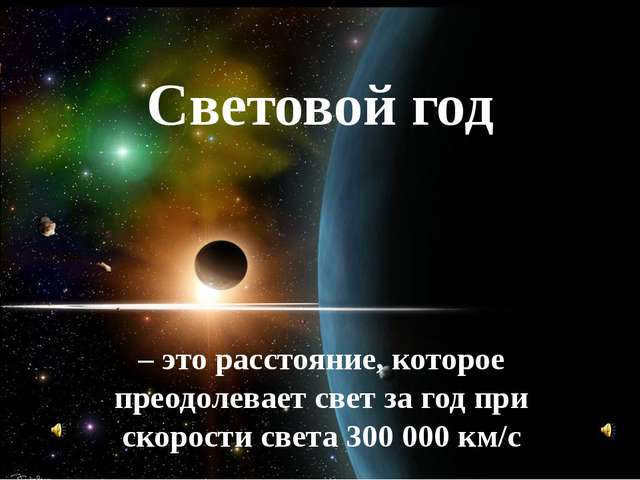
The vast distances between stars make it impossible to measure them in regular units like kilometers or miles. Instead, astronomers use specialized measurements such as light-years and parsecs. For example, they estimate that the minimum distance from Earth to Mars is about 55.76 million kilometers. However, when it comes to stars, the measurement becomes even more complex.
One unit commonly used in astronomy is the astronomical unit, which is used to measure objects within the Solar System and nearby objects in the Universe. An astronomical unit is defined as approximately 149,598,100 kilometers (plus or minus about 750 kilometers), which is roughly the average distance between the Earth and the Sun. Interestingly, modern observations have shown that this distance gradually increases by about 15 centimeters each year, possibly due to the Sun losing mass through solar wind.
A light year is the measurement of the distance that light travels in one year, which is approximately 9,460,730,472,580,800 meters. It’s fascinating to think that the light we see from stars on a clear night has traveled for many centuries to reach our planet, and some of those stars may no longer exist.
A parsec, also known as the “parallax of an angular second,” is a unit of measurement that represents the distance at which the average radius of the Earth’s orbit, when viewed from an angle of one arc second, appears perpendicular to the line of sight. Simply put, a parsec is equivalent to 3.26 light years.
What’s interesting is that while the concept of a light year is commonly used in popular science and science fiction literature, parsecs are typically only utilized in professional writings and research.
(Galaxy UDFj-39546284, located 13.3 billion light-years away from Earth, can be observed as a small red dot in the image captured by the Hubble telescope )
The nearest star to our planet is Alpha Centauri, which is situated approximately 4.37 light-years away. However, the most distant galaxy discovered so far (as of December 2012) is located a staggering 13.3 billion light-years away from Earth! This means that when the sun of this particular galaxy (referred to as UDFj-39546284) eventually ceases to exist, humans may not become aware of it for a considerable amount of time.
Distances represented numerically
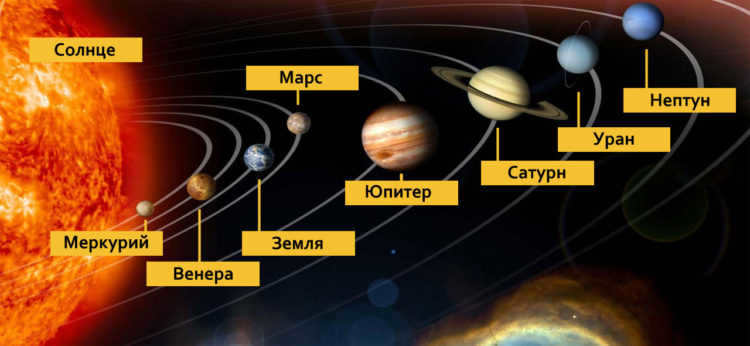
- Mercury is situated closest to the Sun, at an average distance of 0.387 astronomical units (58 million km), and its distance from Earth ranges from 82 to 217 million km. This planet follows a highly elongated elliptical orbit around the Sun, with its plane inclined at an angle of 7 degrees to the ecliptic plane.
- Venus is the second farthest planet from the Sun, with an average distance of 0.72 astronomical units (108.2 million km). It has a radius of approximately 6051 km, a mass of 4.9 x 10^24 kg (equivalent to 0.82 Earth masses), and an average density of 5.24 g/cm3.
- Mars is positioned as the fourth celestial body from the Sun, maintaining an average orbital distance of 1.5 astronomical units (227.9 million km). The closest possible distance between Earth and Mars measures approximately 55.75 million km, while the farthest reaches about 401 million km.
- Jupiter holds its place as the fifth planet in our Solar System and stands as the largest in terms of size. It maintains an average distance from the Sun of 5.2 astronomical units (778 million km). Its equatorial radius measures 71.4 thousand km, while its polar radius hovers around 67 thousand km. In terms of mass, Jupiter weighs in at 1.9 x 10^27 kg (equivalent to 317.8 Earth masses). The average orbital velocity of Jupiter in its path around the Sun is approximately 13.06 km/s.
- Uranus is the seventh planet in our solar system, located at an average distance of 19.18 astronomical units (or 2,871 million kilometers) from the Sun. It was first discovered in 1781 by the renowned English astronomer William Herschel and was given its name in honor of the Greek god of the sky, Uranus. This fascinating planet has an average radius of 25,560 kilometers and a mass of 8.69 x 10^25 (or 14.54 times the mass of Earth). Furthermore, it boasts an average density of 1.27 grams per cubic centimeter.
- Neptune is the eighth planet in our solar system and is the fourth largest planet. It was first discovered on September 23, 1846, at the Berlin Observatory by the German astronomer Johann Halle. The discovery was based on predictions made independently by the English mathematician John Adams and the French astronomer Urbain Leverrier. With an average distance from the Sun of 30.1 astronomical units (4497 million km), Neptune has an average radius of approximately 25,000 km. Its mass is 1.02 x 10^26 kg (which is equivalent to 17.2 times the mass of Earth), and its density is 1.64 g/cm3.
- Pluto was named after the ancient Roman god of the underworld. Initially, scientists believed that Pluto had a mass similar to that of Earth, but it was later discovered that Pluto’s mass is actually nearly 500 times less than Earth’s, and even less than the Moon’s. Specifically, Pluto’s mass is 1.2 x 10^22 kg, which is only 0.22 times the mass of Earth. In terms of distance from the Sun, Pluto is located at an average distance of 39.44 astronomical units (5.9 x 10^12 km), and it has a radius of approximately 1.65 thousand kilometers.
What are the techniques used to measure the distances between stars?
The laser positioning and radiolocation method
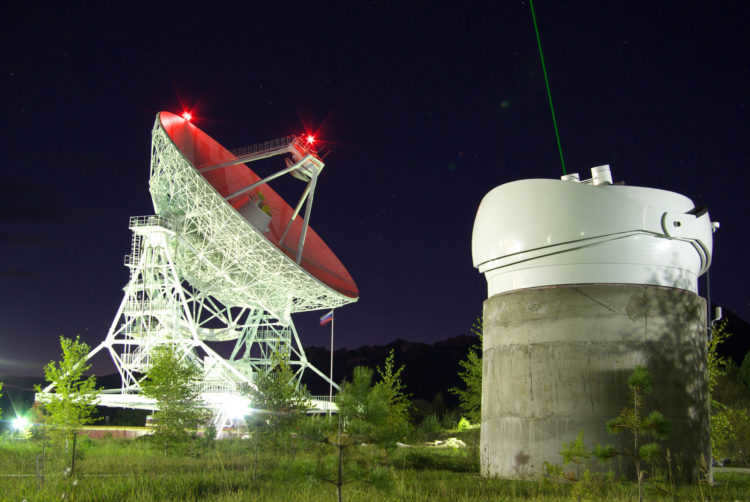
These two advanced techniques are utilized to ascertain the precise distance to an entity within the solar system. The process is conducted as follows. Utilizing a potent radio transmitter, a directed radio signal is emitted towards the object under observation. The entity then reflects the received signal and sends it back to Earth. The duration for the signal to traverse the path determines the distance to the entity. The precision of radiolocation is merely a few kilometers. In the case of laser location, instead of a radio signal, a laser emits a beam of light, which enables the determination of the distance to the entity through similar calculations. The precision of laser location is achieved to the level of fractions of a centimeter.
Method of determining trigonometric parallax
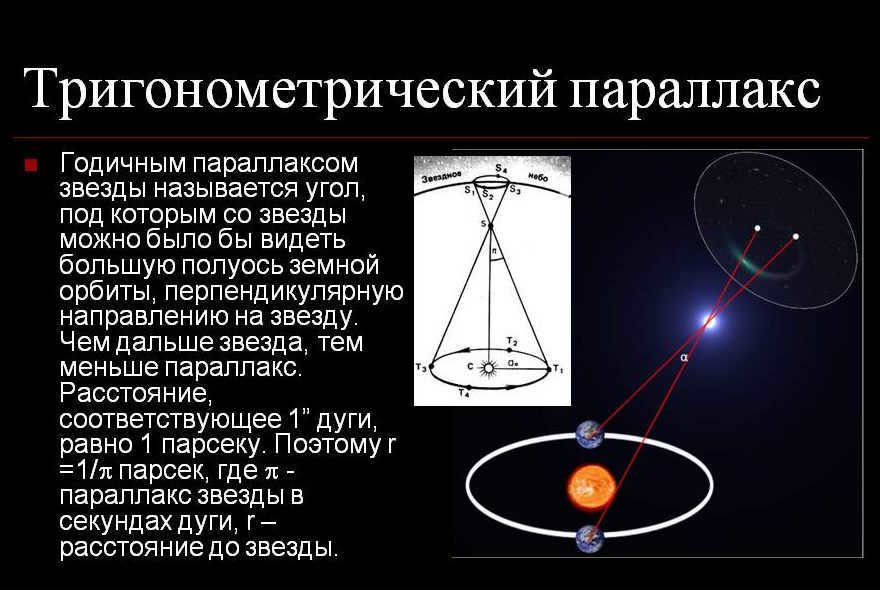
The trigonometric parallax method is the most straightforward technique for measuring the distance to distant celestial objects. It relies on basic principles of geometry and involves the following steps. First, a baseline is drawn between two points on the Earth’s surface. Next, an object in the sky, whose distance we wish to determine, is selected as the vertex of the resulting triangle. The angles between the baseline and the lines connecting the chosen points to the celestial body are then measured. By utilizing the side and two adjacent angles of the triangle, it is possible to calculate all other elements of the triangle.
This method is not very practical for studying objects from Earth because the Earth’s atmosphere interferes and makes it impossible to determine the annual parallax of objects that are more than 100 parsecs away.
However, in 1989, the European Space Agency launched the Hipparcos space telescope, which enabled the determination of stars up to a distance of 1000 parsecs. The data obtained from this telescope allowed scientists to create a three-dimensional map of the distribution of these stars around the Sun. In 2013, ESA launched the Gaia satellite, which has 100 times better measurement accuracy and can observe all the stars in the Milky Way. If human eyes had the same accuracy as the Gaia telescope, we would be able to see the diameter of a human hair from a distance of 2,000 km.
The method of the standard candle
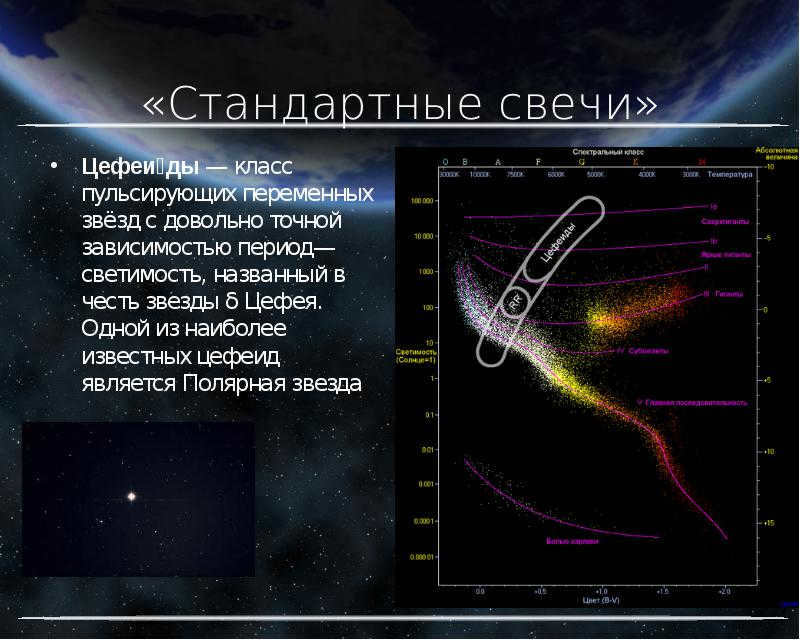
The standard candle technique is utilized for determining the distances to stars in other galaxies and the distances to those galaxies themselves. It is common knowledge that the further away the light source is from the observer, the less bright it appears. In other words, the brightness of a light bulb at a distance of 2 meters will be four times lower than at a distance of 1 meter. This principle is applied to measure the distance to objects using the standard candle method. By drawing a comparison between a light bulb and a star, it becomes possible to compare distances to light sources with known luminosities.
In astronomy, standard candles are objects whose luminosity, which is analogous to the power of the source, is known. These objects can be any type of star. To determine the luminosity of a star, astronomers analyze its surface temperature, which is based on the frequency of its electromagnetic radiation. By knowing the temperature, we can determine the spectral class of the star and then use the Hertzsprung-Russell diagram to find out its luminosity. With the values of luminosity and the measurement of the star’s brightness (apparent magnitude), we can calculate the distance to the star. This type of standard candle provides us with a general estimate of the distance to the galaxy in which it is located.
Nevertheless, this approach requires a significant amount of manual work and does not offer precise results. As a result, astronomers find it more practical to rely on cosmic objects with distinct characteristics and known luminosity as standard candles.
Measuring Redshifts
This technique, known for its extensive reach, enables the determination of distances to the most remote regions of the Universe by evaluating redshifts.
We are all familiar with the typical range of sunlight, which resembles a regular rainbow: the colors range from red to blue. Each chemical element has its own radiation spectrum, which consists of these lines. The position of these lines for each element is recorded. By analyzing the spectra of different stars that contain various elements, we can observe that their lines appear to shift towards the red end of the spectrum. This shift in wavelength results in a decrease in energy, hence why it is known as redshift.
Edwin Hubble, the namesake of the renowned space telescope, was able to piece together the larger picture and demonstrate that the rate at which a galaxy moves away from us is directly proportional to its distance. He accomplished this by comparing the spectra of galaxies with their respective distances.
The concept of cosmological redshift can be illustrated in the following way: imagine a beam of light, which is an electromagnetic wave originating from a remote galaxy. As this light travels through space, the space itself expands. Consequently, the wave also expands, leading to a change in its wavelength. For instance, if the space has expanded by a factor of two during the journey of the light, the wavelength of the wave will double.
The redshift phenomenon, which was initially observed by Hubble, provides evidence for the expansion of the Universe. This means that the longer we delay interstellar travel, the greater the distance we will have to cover in the future.

A team of astronomers from the United Kingdom has devised an ingenious and straightforward method for gauging the distances between stars and Earth. This groundbreaking technique allows scientists to determine the distance to our planet for any star in the Milky Way by utilizing its “twin” counterpart, which possesses an identical size and spectrum. The findings of this research were published in the esteemed journal Monthly Notices of the Royal Astronomical Society.
According to Pfeil and his colleagues, astronomers presently use a method known as parallax to accurately determine the distance to faraway stars. This method involves measuring how much the star in question appears to shift in relation to background objects as the Earth orbits the Sun. However, parallax can only be used for stars that are relatively close to us, within a range of about 1-2 thousand light-years from Earth. As a result, astronomers have only been able to determine the exact distance for 100,000 out of the Milky Way’s 100 billion stars. Although it is possible to measure the distances to more distant stars, Pfeil explains that the current techniques rely on statistical models and assumptions about the star’s temperature or chemical composition, which can introduce significant errors into the measurements.
In an effort to minimize potential errors and discrepancies in measurements, Pfeil’s team stumbled upon a groundbreaking yet straightforward concept – identifying stars with similar spectra to those with accurately measured parallaxes, and calculating their distances based on differences in brightness.
Scientists have put their method to the test using 175 pairs of stars with identical spectra, one of which was situated far from Earth while the other was within a range of 1-2 thousand light years. The calculated distances to the more distant “twin” stars closely matched the results obtained through other techniques, validating the viability of this approach for determining distances to remote celestial bodies.
Soon, Pfeil and his team have intentions to document twin star pairs, as well as endeavor to determine the precise magnitude of the Galaxy, spanning from one extremity to the other.
Video
The issue of how the distance between stars is measured often arises among those who are not familiar with the subject, especially when the media starts reporting on sensational discoveries in our solar system. There is a common misconception that this topic has been thoroughly researched and that there is nothing new to be discovered.

Unique Measurements
In order to calculate the distance between stars in constellations, specific calculations and methods are employed. These techniques are limited in number. Unconventional parameters are mentioned in various media articles. They are utilized to determine the distance to stars, although the average individual is more accustomed to measurements in the standard SI system, which is also employed in the field of astronomy.

Calculations necessitate the use of relative values, which can be assumed as constant in such computations. Although they may vary annually, the changes are minimal and can easily be accounted for in the calculations.
In 2018, a telescope positioned on the Mauna Kea volcano made another astounding discovery. The Minor Planet Center of the International Astronomical Union joyfully announced this finding. The newly found celestial object was given the name “Farout”, deriving from the English words “distant” or “remote”.
The pink dwarf planet, which was previously recognized as the favorite for distance over Pluto, was found to be farther away. Not only was its status as a planet stripped away, but other discoveries were made in the 21st century as well. Following Erida, Kwawar, and its companion Wavot, Makemake and Sedna reported the discovery of Farout, which is located 120 astronomical units away.
Journalists report that the diameter of the dwarf planet is 500 kilometers, which is one-tenth of Mercury’s diameter, making it the smallest planet in the solar system.
To better illustrate the vastness of the distance from Earth, it is said that Farout is 120 times farther away than our planet. As for the distance from the Sun, it is known to be approximately 150 million kilometers.
It is imperative to popularize scientific knowledge in order to disseminate such sensational reports. However, it is sufficient to note that the recently discovered celestial object orbits the star at an extremely slow pace, requiring a thousand years for a single revolution.

The vastness of space and the immense distances between celestial bodies can be quantified using various units of measurement:
However, when it comes to measuring astronomical distances, millions of kilometers are not sufficient. Alternative scales are necessary to accurately determine the distance of stars or illustrate the vastness of celestial objects. The boundless expanse of space can be measured in terms of the speed of light.

How the distance to the stars is quantified
Humanity requires a range of metric units to accurately quantify distance, remoteness, and size on various scales. The selection of units for measuring distance depends on the magnitude of the object or the extent of the distance being measured.
For example, the path of a snail can be easily measured in centimeters, while nearby objects are typically measured in meters. When dealing with significant distances on Earth, kilometers are commonly used in the International System of Units (SI), although some countries still use miles.
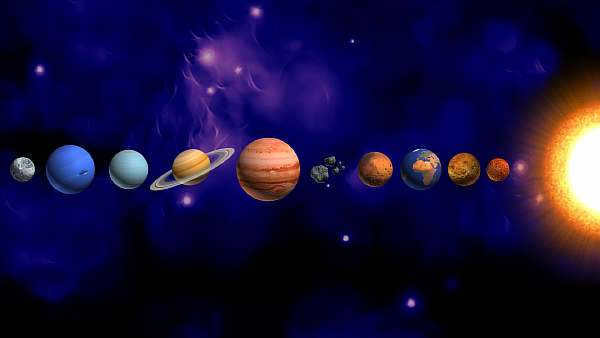
When it comes to outer space, the distance between Earth and the main star is so vast that it is often represented by a complex combination of symbols. To simplify this, scientists introduced the concept of an astronomical unit, which provides an average value for such distances.
However, when it comes to objects like the Galaxy, the numbers involved are so massive that even the astronomical unit can be insufficient for obtaining the desired answer. To address this, terms such as “light-year,” “parsec,” “megaparsec,” and “kiloparsec” were introduced. These terms allow for a more convenient calculation or expression of the average distance between stars.

There are several important points to consider:
- The astronomical unit (a. e.) is the estimated distance between a star and a third planet. It has been measured multiple times, refined, and adjusted. The most recent recorded measurement is 149,597,870.66 km. This figure represents both the distance from the center of the Galaxy and the numerical value of the astronomical unit at the close of the previous century, which has remained unchanged since then. If the blue planet is 10 a. e. away from the blue planet, this measurement is simply multiplied by 10. However, if an exact value is required, the radius of the planet’s circular orbit is used as the basis. This assumption holds true if we disregard other interactions with celestial bodies besides the Sun, around which the planet revolves. However, this value falls short when measuring distances to stars – particularly Alpha Centauri or the Big Dipper. Astronomers employ different formulas and constants to calculate these distances.
- Parsec (pk) is a hypothetical measurement. When asked for its equivalent value in meters, the answer would be 206,265 astronomical units, or 31 * 10^15 meters (a number with 15 zeros). Even larger distances require new units of measurement. These units are derived from the astronomical unit using the parsec, but are based on the speed of light, which is 300,000 kilometers per second. And this is a completely real value obtained through the measurement of the speed of light.
- A light year is the distance traveled by a beam of light in one year, continuously and at a constant speed. Roughly speaking, the average value of a parsec is 3 light years (1 pc is equal to 0.3066 light years).
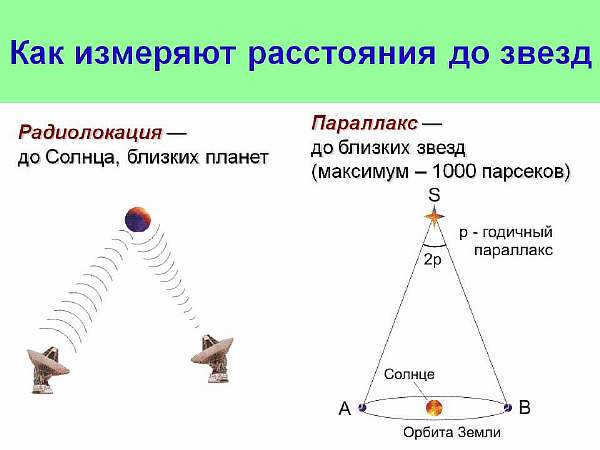
Application of human knowledge
The Milky Way is an immense expanse of space that contains planets, visible stars, and constellations. This is generally the extent of knowledge that the average person, who is not well-versed in outer space, possesses. Additionally, there are also other galaxies such as the Andromeda Galaxy, the Triangle Galaxy, and around forty smaller dwarf satellite galaxies.
Our galaxy has a diameter of 100,000 light years. This is a vast distance where no emergency services can come to the rescue. Therefore, the current focus of research is primarily centered around the provided sample units for measuring cosmic distances.
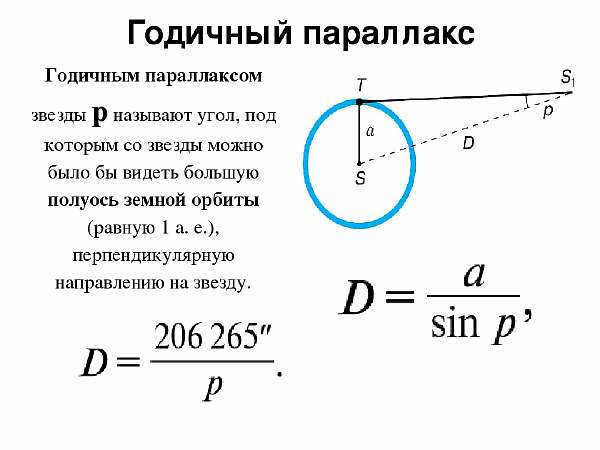
As astronomy continues to make new advancements, it is possible that alternative ratios will emerge out of necessity.
Currently, the distance to distant stars can be measured by using the main sequence. In the past, the Pleiades or the Hyades were always relied upon for this purpose. However, now Cepheids, which are giant stars, are being used.
Up to 30 Mpc can serve as a reference point. Human beings are unable to see any further than that at the moment. We require additional landmarks or improved instruments that will allow us to reach the next level of the distance ladder.
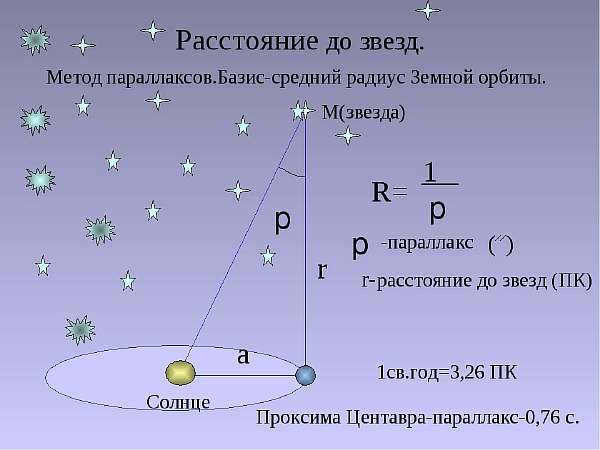
A Brief Historical Overview
Throughout history, humankind has maintained a deep fascination with the celestial realm. It is only natural, as the night sky captivates our attention, inspires dreams and speculations, and drives us to seek new knowledge.
In ancient times, the general populace did not ponder much on celestial distances. Many believed the sky to be solid, with stars serving as holes through which light entered the Earth. However, there were individuals who recognized the fallacy of this belief and understood the immense scope of the cosmos, prompting them to advocate for its meticulous exploration.

The ancient Greeks deserve credit for their ability to accurately determine the distance to the celestial bodies visible to the human eye. Their use of simple angular measuring tools, logic, and calculations allowed them to establish dimensional concepts that have remained virtually unchanged for 2 millennia. It is truly remarkable how the human mind has the power to do this. Six hundred years ago, the Italian astronomer Cassini accurately determined a parameter that is still used in all space calculations and computations today.
Around that time, the esteemed Halley, who made numerous advancements in the field of space science, suggested utilizing the transit of Venus, Earth’s neighboring planet, across the solar disk as a reference point for calculations.

The groundbreaking discoveries made by exceptional astronomers have had a tremendous impact:
The unfathomable distances in outer space did not pose a hindrance to measurement or the development of new measurement units. These discoveries served as the bedrock for modern science.
They paved the way for the creation of space shuttles and stations, manned rockets, and even supersonic airplanes.

The Herculean effort put in by medieval astronomers is indispensable in the current research. Their tireless observation of planetary and stellar movements has paved the way for the utilization of cutting-edge research tools in various calculations.
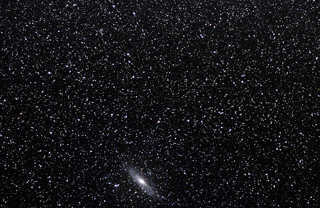
The vastness of interstellar distances renders attempts to measure them in kilometers or miles futile, as these measurements would be filled with endless strings of zeros. Instead, a standardized system of measurement is employed to express these distances. For instance, it is commonly stated that the minimum distance between Earth and Mars is approximately 55.76 million kilometers. However, when dealing with celestial bodies, the situation becomes more intricate, necessitating the use of the light-year and parsec as units of measurement.
Astronomic unit
An astronomic unit is a unit of measurement used in astronomy to describe the distances between objects within the Solar System and the closest objects in the Universe. The astronomic unit is equivalent to 149 598 100 km (+- ~750 km), which is roughly the average distance from the Earth to the Sun. Recent observations have noted a gradual increase in this value, growing by 15 cm each year. This phenomenon is believed to be a result of the Sun potentially losing mass due to the effects of solar wind.

Definition of Light year
A Light year is the distance that a beam of light travels within the span of one Earth year. In scientific terms, this distance is equivalent to 9,460,730,472,580,800 meters. It’s fascinating to consider that the twinkling stars we observe in the night sky have traversed through the vastness of space for several centuries in order to reach our humble planet. What’s even more mind-boggling is the notion that some of these celestial bodies have long ceased to exist, yet their light persists and continues to grace our eyes.
Parsec
Parsec. Also known as the “parallax of an angular second,” a parsec is the distance at which the average radius of the Earth’s orbit (perpendicular to the line of sight) is observed at an angle of one arc second. In simpler terms, a parsec is equal to 3.26 light-years.
What is fascinating is that while the concept of a light-year is commonly used in popular science and science fiction literature, parsecs are typically reserved for professional writings and research.
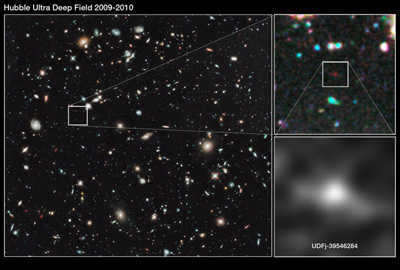
(Galaxy UDFj-39546284, captured by the Hubble telescope, appears as a red dot and holds the title of the most distant galaxy from Earth, located 13.3 billion light-years away)
Alpha Centauri is the star closest to our planet, positioned approximately 4.37 light years away. However, the most remote galaxy (as of December 2012) boasts a staggering distance of 13.3 billion light-years from Earth! This means that when the sun in this very galaxy (known as UDFj-39546284) eventually fades away, humanity will not learn of its demise until much later.

Scientifically speaking, the distance from the Earth to space, measured in kilometers (km), is approximately equal to the distance from the planet’s surface to the outer edge of its atmosphere, where the vast expanse of the cosmic vacuum begins. In the quest to explore space, the Gemini 11 spacecraft reached the highest altitude in human history until the 1970s, reaching 1,372 kilometers. However, this achievement was still far from the ultimate goal, representing only a hundredth of the necessary distance from Earth.

Understanding Outer Space
The vast expanse that separates the Earth from the depths of space is an extensive voyage, culminating in the crossing of the Earth’s atmospheric boundary and the entry into the emptiness of the cosmos. This extraordinary journey commences at the outer edges of any celestial body where its protective layers cease to exist.

According to ancient Greek astronomers, the cosmos was believed to be located at the precise place where the boundaries of the atmosphere surrounding the Earth were demarcated.
The Earth was positioned at the center of the universe in the geocentric system, with the vacuum surrounding it being an essential element of the cosmic order.
Several points should be highlighted:
- The beginning of space was marked by the end of the atmosphere, and this remains unchanged. In modern science, the boundary of the atmospheric layers is considered to be approximately the distance to outer space. However, there is still no definitive consensus on this matter.
- From a legal standpoint, the issue was resolved in a rather straightforward manner. The International Aviation Federation has designated the Karman line as both the upper boundary of the atmosphere and the dividing line between Earth and outer space. Interestingly, outer space is an intriguing paradox that combines the concepts of boundless space and the limited distance between specific objects.
- For representatives of the IAF, there was no uncertainty regarding the definition of space. Since reaching the first orbital velocity is required at this altitude, it can be concluded that an altitude of 100 kilometers determines the beginning of space. Unfortunately, uninformed sources and media outlets with limited knowledge of astronomical terms often incorrectly portray the daring spacewalks of stratonauts or astronauts working on the ISS.
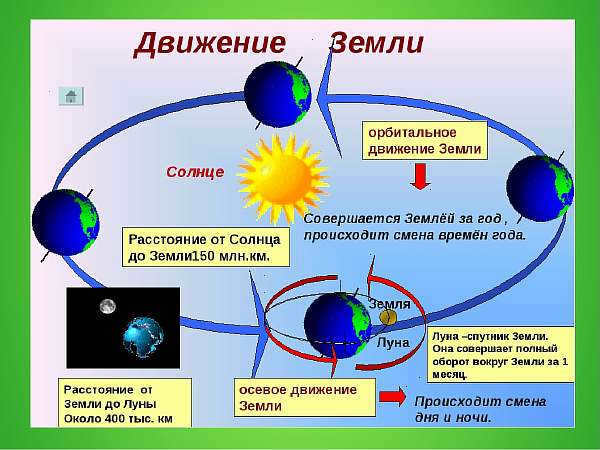

Distance between Earth and Stars
When considering the distance between Earth and space, as well as the International Space Station (ISS), it is important to understand that the ISS is not actually located in outer space. Instead, it remains at a distance of 353 to 400 km from the Earth’s surface, which is still within the Earth’s rarefied atmosphere known as the thermosphere. This is a fact that any scientist with knowledge of the atmosphere will confirm. Beyond the thermosphere lies the exosphere, which extends for 10,000 kilometers.

The International Space Station (ISS) has provided NASA with justification for defining the boundary of space at an altitude of 122 kilometers. This is the point at which the spacecraft can only maneuver using a rocket engine, as conventional methods are ineffective.
There have been some rather amusing attempts to establish a distance of 8 kilometers as the start of space, based on the argument that this is where meteors entering the Earth’s atmosphere begin to burn up.

The question of the distance between stars and the Earth does not have a clear answer according to Wikipedia. One concept to consider is the point at which space begins for the human body. This occurs at approximately 19 kilometers, when the biological fluids within the body reach boiling point due to the extreme drop in atmospheric pressure.

The significance of the term
If we discuss the significance of this concept, it is important to consider the philosophical interpretation, which suggests a specific arrangement of the universe. Referring to the understanding of ancient scholars and perceiving the term “space” as the surrounding area of the world’s center, it becomes meaningless to debate about its distance, as it encompasses the entire region around the Earth.

The scientific definition states that the empty area outside of the atmosphere is what constitutes space. Therefore, the answer to the question of how far away space is does not lie in the technical capabilities of the shuttle or the boiling of fluids in humans, but rather at the point where the vast expanse and complete absence of atmosphere begins.
The existence of conventional boundaries, even those defined by reputable terrestrial organizations, does not necessarily indicate that the distance from the Earth’s surface to space is the true distance. Space is comprised of boundless and infinite or limited regions between the atmospheres of celestial bodies:
- 100 kilometers is the boundary of the atmospheric layer that can reflect radio waves. Some argue that it serves as the demarcation between near space and the Earth’s atmosphere;
- The official demarcation point is where the Karman line starts, which requires the first space velocity to be reached in order to cover the distance.
- Almost a century ago, researchers defined the boundary of the atmosphere at 320 kilometers. This was based on the discovery of the Appleton layer, which marks the end of the ionosphere.
- In 1950, the atmospheric boundary was recorded at 1300 km. However, Gemini 11 reached an altitude of 1372 km, casting doubt on this figure.
- At the beginning of the last century, it was believed that the limit of the atmosphere was 80 thousand km. This was almost correct, as the intense action of the Sun on the exosphere begins at this distance.
- Located 90,000 km or 90,000,000 meters away, there exists a collision point where the solar wind and Earth’s magnetosphere converge, giving rise to a shockwave.

It remains only to determine which measurement to use as a reference point.
And thus, we can solve the question of the furthest distance to outer space. The presence of Earth’s magnetic field has made this topic a variable for discussion – ranging from 100,000 to 120,000 kilometers, as this range fluctuates.
If we don’t tie it to specific circumstances and processes in the Universe, the distance to deep space can be confidently identified as the edge of the atmosphere at an altitude of 144,000 kilometers.
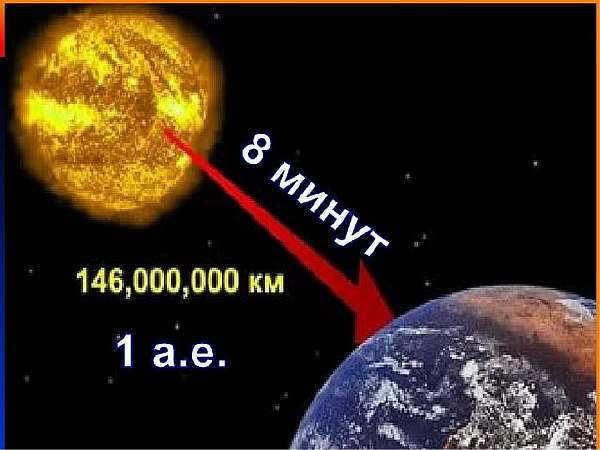
An approximate explanation
Up until now, there is no video footage (captured from a space satellite or spacecraft) available that could accurately determine the exact distance of the Earth’s atmosphere in kilometers. This is because the Earth’s atmosphere transitions into outer space, making it challenging to measure. The measurement process is complicated by the fact that the Universe is constantly changing and not static.

The star, situated at a certain distance from the Earth, is in constant motion and follows the laws of rotation, gravity, reactions, and transformations. Fascinating phenomena can be observed by examining photographs captured by powerful telescopes.
The Earth’s atmosphere is influenced by the star it orbits. The geocorona, also known as the exosphere, is a part of the Earth’s envelope that is believed to consist primarily of hydrogen atoms.
There is a belief that it lasts for approximately half of the distance from Earth to the Moon, which is about 190 thousand kilometers. This distance gets extended due to the expansion of the thermosphere. This phenomenon is observable during times of intense solar activity. As the thickness of the thermosphere grows, the distance between the Earth’s surface and the exosphere also increases.

When calculating this measurement, it is important to keep in mind that during periods of solar activity, the outer layer can expand by up to 40,000 kilometers. In areas without direct sunlight, this expansion can be even greater, ranging from 50 Earth diameters (approximately 600,000 kilometers) to 100 diameters (approximately 1.2 million kilometers).
One can take into account the distance of 260,000 kilometers to space. This is the point where the gravitational force of the Earth ends and the gravitational force of the yellow dwarf starts to have an impact.
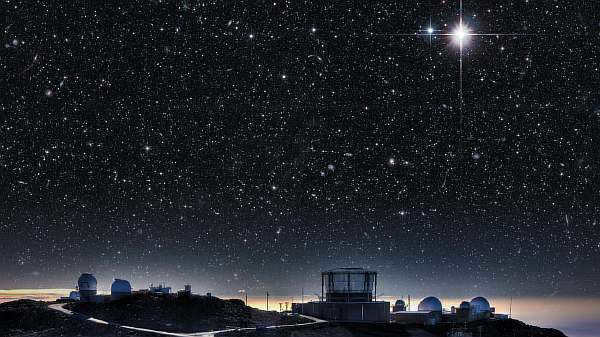
The argumentation becomes even more straightforward in this case: the absence of gravitational force results in the absence of atmosphere that it holds. Hence, this area is considered to be interplanetary space. According to the scientific definition, space is the region that exists between celestial bodies and planets.
When authors of articles on Internet portals and other media platforms mention that astronauts from the International Space Station (ISS) venture into outer space, there is some truth to it.
Indeed, the officially recorded distances are 122 and 100 kilometers.

Scientific research, groundbreaking discoveries, and careful calculations have confirmed the validity of the alternative distance options. Therefore, you can confidently select them as a remote point of reference.

